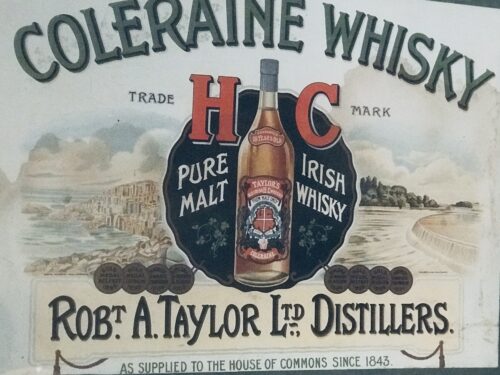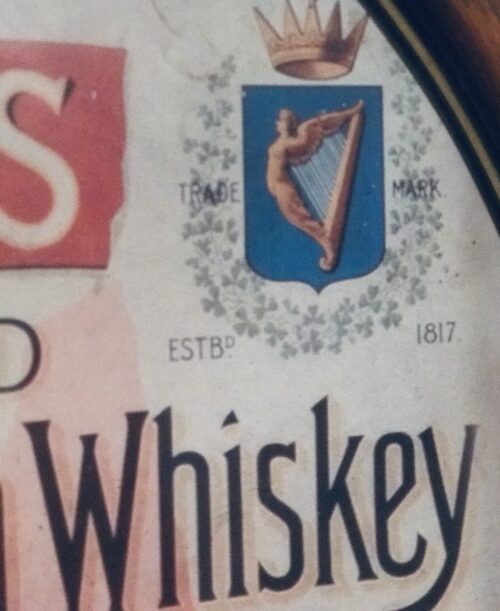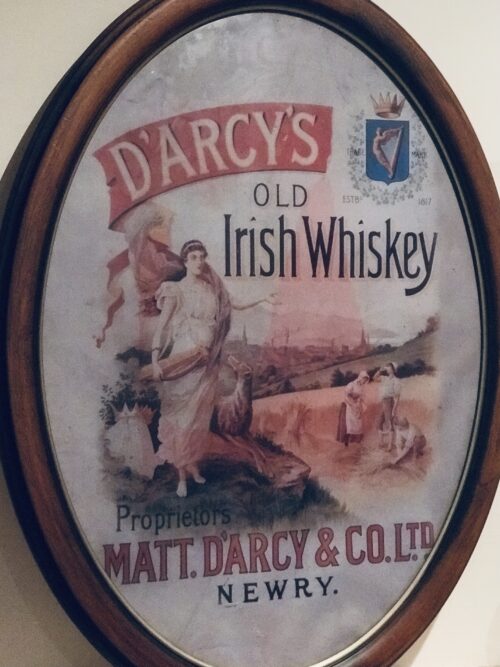History of the DWD Whiskey Distillery

The Dublin Whiskey Distillery Co Rebirth & Redemption
Ireland’s history of whiskey distilling runs long and deep. The word ‘whiskey’ comes from the Gaelic, “uisce beatha”, meaning “water of life”, and Irish whiskey is one of the earliest known distilled beverages in the world, believed to have originated when Irish monks brought the technique of distilling perfumes back to Ireland around 1000 AD. Ever resourceful, the Irish modified this craft to create the wonderful spirit that endures to this day. But Irish whiskey’s most recent past reveals an extraordinary tale of subterfuge and intrigue that belies this golden spirit. The mercurial craft of whiskey making has lost none of its ethereal mystique and remains indelibly woven with what it means to be Irish. It has oiled a rich and eclectic culture that has reached far beyond our island shores. Yet the ‘light music’ appreciated by Joyce hides a dramatic tale of endurance and fortitude that has demanded so much from its leading protagonists. Neither war, nor famine or draconian law, be it home-grown or foreign made, or the shifting sands of empires and nations, or the shallow trends of libatious fashion could halt this most resolute and enduring spirit.
The founder and Master Distiller of the Dublin Whiskey Distillery Company
John Brannick, founder and master distiller of the Dublin Whiskey Distillery Company, was born into a renowned family of Irish whiskey-makers. His father Patrick and his uncles were all established distillers with Sir John Power of “Powers Irish Whiskey” fame, and in time both John and his younger brother Patrick Jr would follow in their father’s footsteps. Like all the great Irish distillers of the 19th century, the Brannick family used traditional “Pot Still” distillation, the simplest and oldest form of distillation, the principles of which have remained unchanged to this day. First, a whiskey “mash” comprised of water and grain is prepared. Yeast is added, causing fermentation, which creates alcohol in a solution known as “distiller’s beer” or “wash”. The “wash” is placed into a round bottomed copper kettle or “Pot Still” and heated to a temperature above the boiling point of alcohol but below that of water. The alcohol evaporates, leaving the water behind, and the vapour rises into a tube where it cools and condenses back into spirit. However, not all spirit is created equal. The early evaporations and the last evaporations, known as “heads” and “tails,” contain impurities, so it is the “heart” or mid part of the distillation process that the distiller seeks. The essence of distillation is timing, knowing when to “cut” between the head, heart and tail and retain only the best spirit. It was this time-honoured process that the young John Brannick learned from his father and uncles, a method to which he faithfully adhered and a skill which he perfected throughout his life. 1845 was a significant year for John Brannick when, at the age of 15, he began his formal apprenticeship at the John’s Lane Distillery. The Powers Distillery was one of the great distilleries of Dublin and young John’s experiences there instilled in him a lifelong passion for the fine art of whiskey-making. At the time, Ireland was an impoverished country with little or no industry. Distilleries constituted a rare exception and they, their owners and employees enjoyed significant status in their communities. The young John Brannick soon demonstrated a natural flair for the craft of whiskey-making. These early years, working within the hallowed halls of the John’s Lane Distillery, laid the foundations for his later exploits within the industry. It wasn’t long before the other great distilleries took note of his growing reputation and in 1852 George Roe & Sons enticed Brannick to join the House of George Roe & Co with the promise that he would some day become a Master Distiller.After nearly 20 years of perfecting his craft with the House of Roe, Brannick had reached the illustrious position of Master Distiller. His reputation amongst the great distilleries of Dublin was now firmly established, but his ambitions didn’t end there. Brannick had long harboured a burning desire to build the finest distillery in the world, and in 1870, having secured the necessary backing, he resigned his position and struck out on his own, establishing the Dublin Whiskey Distillery Company Limited. DWD.For the next two years Brannick worked on a revolutionary design for his distillery. A site was chosen, less than a mile north of Dublin’s city centre, on the banks of the River Tolka, and construction started on 22 July 1872 Exactly one year later, distillation began with the preparation of the first ever DWD wash. Meanwhile, with work on the great distillery underway, Brannick finally fulfilled another long-standing promise and married his sweetheart Mary Hayes on 26 January 1873.
The young John Brannick soon demonstrated a natural flair for the craft of whiskey-making. These early years, working within the hallowed halls of the John’s Lane Distillery, laid the foundations for his later exploits within the industry. It wasn’t long before the other great distilleries took note of his growing reputation and in 1852 George Roe & Sons enticed Brannick to join the House of George Roe & Co with the promise that he would some day become a Master Distiller.After nearly 20 years of perfecting his craft with the House of Roe, Brannick had reached the illustrious position of Master Distiller. His reputation amongst the great distilleries of Dublin was now firmly established, but his ambitions didn’t end there. Brannick had long harboured a burning desire to build the finest distillery in the world, and in 1870, having secured the necessary backing, he resigned his position and struck out on his own, establishing the Dublin Whiskey Distillery Company Limited. DWD.For the next two years Brannick worked on a revolutionary design for his distillery. A site was chosen, less than a mile north of Dublin’s city centre, on the banks of the River Tolka, and construction started on 22 July 1872 Exactly one year later, distillation began with the preparation of the first ever DWD wash. Meanwhile, with work on the great distillery underway, Brannick finally fulfilled another long-standing promise and married his sweetheart Mary Hayes on 26 January 1873.

Aeneas Coffey Inventor of the Continuous “Patent Coffee Still”
In the year in which John Brannick was born, Aeneas Coffey was granted patent #5974 for his design of a two column continuous still or “Patent Still”. The Patent Still represented a revolution in spirit distillation, eliminating the need for multi-distillation using traditional “Pot Stills” and producing a lighter spirit with a higher proof at a fraction of the cost. However, it was shunned by the great Dublin distilleries, who considered the whiskey produced to be bland and tasteless in comparison with their world-famous “Pot Still” creations. They may have also considered the arrival of the Patent Still a direct challenge to their profession, an early form of automation attempting to replace the distiller’s art and skill. Many years later John Brannick, who went on to become one of the great masters of Pot Still whiskey, would reflect on the irony that the year of his birth marked the establishment of the Patent Still, the nemesis of his life’s work
The DWD Legacy is Reborn
Two old friends meet amid the bustle of the city and retire to the Palace Bar on Fleet Street to remember old times. By chance, one of them notices a bottle – a very old, unopened whiskey bottle with a mysterious, faded label – sitting in a glass case behind the bar. A relic of lost times. ‘What is that?’ he asks the barman. With this simple question, not one but two journeys began: a journey back in time into the extraordinary story of the “Finest Whiskey in the World”, a story of one man’s vision, gloriously realised, crushed by history and destroyed in a very Irish betrayal. And a journey into the future, the future of a once-great distillery, dismantled, neglected and forgotten. Until now. After 75 long years, DWD is back. Today’s DWD is not a copy of the past: a simple reproduction for nostalgia’s sake. Since the distillery closed its doors in 1941 the world has moved on and advances in the art of distilling cannot be ignored. But some values are timeless and remain as cherished and respected as they did when John Brannick laid the cornerstone of his great distillery in theglorious summer of 1872: real character, brave resolve and a true sense of belonging. Today’s DWD is the natural heir of its noble ancestor, a modern whiskey that draws on the wisdom of the past. And this is only the beginning of the DWD revival. In time, Brannick’s great house will be rebuilt, his achievements rivalled and perhaps even surpassed. But for now let us raise a glass to the return of the “Finest Whiskey in the World”, and look forward to the glories yet to come.
The Finest Whiskey in The World
Today, Irish whiskey is regulated and controlled both by international law and the Irish Whiskey Association. The definition of Irish whiskey and the method of production is globally agreed and enforced to ensure industry standards are protected and maintained at all times. However, back in 1880 no such legal definitions existed, and the global success of the industry began to attract the attention of disreputable characters intent on passing off various spirits and concoctions as ‘Irish whiskey’. The problem was made worse by the great distilleries of Dublin, which were content to leave bottling and branding to merchants and bonders. This laissez-faire attitude enabled unscrupulous dealers to import cheap Scotch and pass it off as highly desirable Irish whiskey. True to form, John Brannick was one of the first to recognise the danger and take steps to protect both his whiskey and his customers from counterfeit products. In 1880 he introduced the famous DWD Post Still logo to identify and market the DWD brand. He controlled its use tightly, working only with trusted merchants and bonders to ensure the DWD brand was respected and admired as the “Finest Whiskey in the World”.“The extraordinary story of the ‘Finest Whiskey in the World’, a tale of one man’s vision, gloriously realised, only to be crushed by history and destroyed in a very Irish betrayal.” Tomas – DWD Brand Ambassador










 Some original and rare Mitchell mirrors are still surviving today and can be found in some pubs in and around Belfast today
Some original and rare Mitchell mirrors are still surviving today and can be found in some pubs in and around Belfast today
 Some other examples of Mitchell Mirrors which were mass produced for advertising their products
Some other examples of Mitchell Mirrors which were mass produced for advertising their products


























